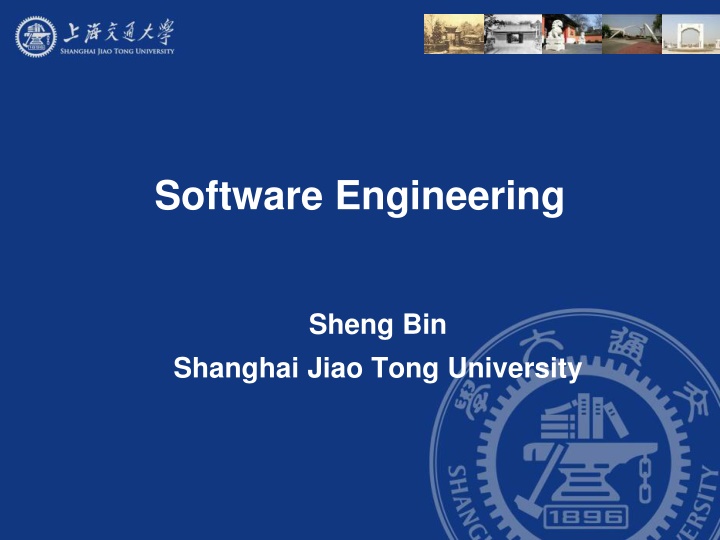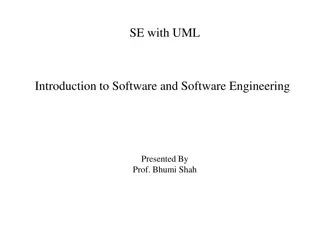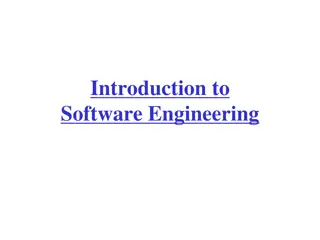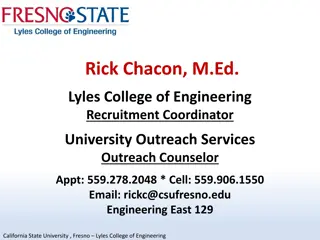Software Engineering Course Overview at Shanghai Jiao Tong University
"Explore the comprehensive Software Engineering course at Shanghai Jiao Tong University taught by Bin Sheng. Covering key concepts, project deliverables, team projects, and reference books, the course emphasizes software life-cycle models, tools, testing, reusability, and more. Engage in team projects, project milestones, and learn from industry-standard reference materials to enhance your understanding of software engineering practices."
Download Presentation

Please find below an Image/Link to download the presentation.
The content on the website is provided AS IS for your information and personal use only. It may not be sold, licensed, or shared on other websites without obtaining consent from the author.If you encounter any issues during the download, it is possible that the publisher has removed the file from their server.
You are allowed to download the files provided on this website for personal or commercial use, subject to the condition that they are used lawfully. All files are the property of their respective owners.
The content on the website is provided AS IS for your information and personal use only. It may not be sold, licensed, or shared on other websites without obtaining consent from the author.
E N D
Presentation Transcript
Software Engineering Sheng Bin Shanghai Jiao Tong University
Course Information Teacher: Bin Sheng( ) SEIEE3-511, 15026790946, shengbin@cs.sjtu.edu.cn Teaching Assistant: Li XIA( ) ziggzagg@sjtu.edu.cn Project Mentors: Course Website: http://www.cs.sjtu.edu.cn/~shengbin/course/SE/sesite/home.html Software Engineering
Course Overview Part A: Software Engineering Concepts 2. 3. 4. 5. 6. 7. 8. 9. Software Life-Cycle Models The Software Process Teams The Tools of the Trade Testing From Modules to Objects Reusability and Portability Planning and Estimating Software Engineering
Course Overview Part B: The Workflows of the Software Life Cycle 10. Key Material from Part A 11. Requirements 12. Classical Analysis 13. Object-Oriented Analysis 14. Design 15. Implementation 16. Postdelivery Maintenance 17. More on UML 18. Emerging Technologies Software Engineering
Team Projects Form teams of 3 ( 1?) students DEADLINE: Sept 28, 2014 After that, teams assigned randomly Project Ideas: Pls refer to the project presentation ppt. No more than two (2) groups working on the same project One (1) new project allowed Email your project idea ASAP, before proposal is due, for feedback. 5 Software Engineering
Project Deliverables Assignment + Attendance= 30% Project=70% Item Due date Sept 28 1. Proposal 2. First report (Specification only) Part 1 (Statement of Work & Requirements) Part 2 (Functional Requirements Spec & UI) Full Report #1 3. Second report (Design only) Part 1 (Interaction Diagrams) Part 2 (Class Diagram and System Architecture) Full Report #2 4. First demo 5. Third report (All reports collated) 6. final demo 7. Electronic Project Archive Oct 31 Oct 31 Oct 31 Software Engineeri ng Dec 1 Dec 8 Dec 15 Dec 2 .. Dec 27 Dec 31 ... Dec 3 SE Practice Each group will have a mentor to guide the development of the project. 6 Software Engineering
Reference book: 1. Stephen Engineering 8th Edition, McGraw-Hill. R Schach, Object Oriented And Classical Software 2. Bruegge & Dutoit: UML, Patterns and Java, Third Edition, Prentice Hall, 2010. Object-Oriented Software Engineering, Using 3. Sommerville, Ian: Software Engineering,9thEdition, Addison Wesley. 4. Miles & Hamilton: Learning UML 2.0, O Reilly Media, 2006. ISBN: 0- 596-00982-8 Software Engineering
Why should we learn SE Why should we learn SE? Because you are from Computer Science SE is the best jobs best job of 2011, Career Cast Best Jobs in America 1. Software engineer 2. College professor 3. Financial advisor 4. Human resources manager 5. Physician assistant 6. Market research analyst 7. Computer/IT analyst 8. Real estate appraiser 9. Pharmacist 10. Psychologist Money Magazine recently published "Best Jobs in America" Software Engineering
Average Annual Wages Source: US Department of Labor/Bureau of Labor Statistics (Occupational Employment Surveys) According to the BLS, software engineering unemployment was 4.6% in 2010, compared to 5.4% for electrical engineers. Software Engineering
Software Q : If you have to write a 10,000 line program in C to solve a problem, how long will it take? Answers: generally range from 2-4 months Let us analyze the productivity Productivity = output/input resources In SW output is considered as LOC Input resources is effort - person months; overhead cost modeled in rate for person month Though not perfect, some productivity measure is needed, as project has to keep it high Software Engineering
Software The productivity is 2.5-5 KLOC/PM Q: What is the productivity in a typical commercial SW organization ? A: Between 100 to 2000 LOC/PM Q: Why is it low, when your productivity is so high? (people like you work in the industry) A: What the student is building and what the industry builds are two different things Software Engineering
Software Students build: student software Industry builds: industrial strength Systems What is the difference between student software and industrial strength software for the same problem? Software Engineering
Software Student Developer is the user Works for the typical case most of the time Bugs are tolerable UI not important No documentation Industrial Strength Others are the users Works robustly Bugs not tolerated UI very important issue Documents needed for the user as well as for the organization and the project Software Engineering
Software Student SW not in critical use Reliability, robustness not important No investment Don t care about portability Industrial Strength Supports important functions / business Reliability , robustness are very important Heavy investment Portability is a key issue here Software Engineering
Industrial Strength Software Student programs != industrial strength software Key difference is in quality (including usability, reliability, portability, etc.) High quality requires heavy testing, which consumes 30-50% of total development effort Requires development be broken in stages such that bugs can be detected in each Good UI, backup, fault-tolerance, following of stds etc all increase the size for the same functionality Software Engineering
Industrial strength software If 1/5thproductivity, and increase in size by a factor of 2, industrial strength software will take 10 times effort Brooks thumb-rule: Industrial strength SW costs 10 time more than student SW In this course, software == industrial strength software Software Engineering
What is software? Computer programs and associated documentation Software products may be developed for a particular customer or may be developed for a general market Software products may be Generic - developed to be sold to a range of different customers Bespoke (custom) - developed for a single customer according to their specification Software Engineering
Software is Expensive Rough cost estimate Productivity = 500 LOC/PM Cost to the company = $10K/PM Cost per LOC = $20 So each line of delivered code costs about $20. A simple application for a business may have 20KLOC to 50KLOC Cost = $100K to $1Million Can easily run on $10K-$20K hardware So HW costs <<< SW costs. Software Engineering
Software is Expensive The HW/SW ratio for a computer system has shown a reversal from the early years. In 50s , HW:SW :: 80:20 In 80s , HW:SW :: 20:80 So, SW is very expensive Importance of optimizing HW is not much More important to optimize SW Software Engineering
Software is Complex Complex complicated Complex = composed of many simple parts related to one another Complicated = not well understood, or explained Software Engineering
Complexity Example: Scheduling Fence Construction Tasks Nailing Painting Setting posts [ 3 time units ] Cutting wood [ 2 time units ] [ 2 time units for unpainted; 3 time units otherwise ] [ 5 time units for uncut wood; 4 time units otherwise ] Setting posts Nailing, Painting Cutting Nailing shortest possible completion time = ? [ simple problem, but hard to solve without a pen and paper ] Software Engineering
More Complexity Suppose today is Monday, Sept 9, 2013 What day will be on January 3, 2014? [ To answer, we need to bring the day names and the day numbers into coordination, and for that we may need again a pen and paper ] Software Engineering
Late & Unreliable 20-25% of SW projects never complete Because after some time they realize that the final cost will be much higher Many companies report runaways Budget & cost out of control Consulting companies to help control them One defense survey found that 70% of the equipment problems are due to SW Software Engineering
Why is SW Unreliable? SW failures are different from failures of mechanical or electrical systems In software, failures are not due to aging related problems Failures occur due to bugs or errors that get introduced during development The bug that causes a failure typically exists from start, only manifests later Software Engineering
Maintenance Once SW delivered, it enters maintenance phase Why is maintenance needed for SW when it does not wear with age? Residual errors requiring corrective maintenance Upgrades and environment changes adaptive maintenance Over SW lifetime, maintenance can cost more than the development cost of SW Software Engineering
What is Software Engineering? Problem domain discussed before, now we discuss the area of SE SE (IEEE): systematic approach to development [ .] of software Systematic approach: methodologies and practices that can be used to solve a problem from problem domain 2 Software Engineering
What is SE? The SWEBOK Knowledge Areas (KAs) Software requirements Software design Software construction Software testing Software maintenance Software configuration management Software engineering management Software engineering process Software engineering tools and methods Software quality http://www.computer.org/portal/web/swebo k/html/ch1 Software Engineering
Basic Problem CS3130 SOFTWARE ENGINEERING 2 Software Engineering
The Role of Software Engg. (1) A bridge from customer needs to programming implementation Software Engineering Customer Programmer First law of software engineering Software engineer is willing to learn the problem domain (problem cannot be solved without understanding it first) 29 Software Engineering
The Role of Software Engg. (2) Customer: Requires a computer system to achieve some business goals by user interaction or interaction with the environment in a specified manner System-to-be System-to-be Environment Software-to-be Software-to-be User Software Engineer s task: To understand how the system-to-be needs to interact with the user or the environment so that customer s requirement is met and design the software-to-be Programmer s task: To implement the software-to-be designed by the software engineer May be the same person 30 Software Engineering
Second Law of Software Engineering Software should be written for people first ( Computers run software, but hardware quickly becomes outdated ) Useful + good software lives log To nurture software, people must be able to understand it 31 Software Engineering
Software Engineering Blueprints Specifying software problems and solutions is like cartoon strip writing Unfortunately, most of us are not artists, so we will use something less exciting: UML symbols However 32 Software Engineering
What is software engineering? Software engineering is an engineering discipline which is concerned with all aspects of software production Software engineers should adopt a systematic and organised approach to their work use appropriate tools and techniques depending on the problem to be solved, the development constraints and the resources available Software Engineering
What is the difference between software engineering and computer science? Computer Science Software Engineering is concerned with the practicalities of developing delivering useful software theory fundamentals Computer science theories are currently insufficient to act as a complete underpinning for software engineering Software Engineering
Computer Scientist Proves theorems about algorithms, designs languages, defines knowledge representation schemes Has infinite time Engineer Develops a solution for an application-specific problem for a client Uses computers & languages, tools, techniques and methods Has finite (usually not enough) time Software Engineer Works in multiple application domains Has only 3 months... while changes occurs in requirements and available technology Software Engineering
What is the difference between software engineering and system engineering? System engineering is concerned with all aspects of computer-based systems development including hardware, software and process engineering Software engineering is part of this process System engineers are involved in system specification, architectural design, integration and deployment Software Engineering
What is a software process? A set of activities whose goal is the development or evolution of software Generic activities in all software processes are: Specification - what the system should do and its development constraints Development - production of the software system Validation - checking that the software is what the customer wants Evolution - changing the software in response to changing demands Software Engineering
What are the costs of software engineering? Roughly 60% of costs are development costs, 40% are testing costs. For custom software, evolution costs often exceed development costs Costs vary depending on the type of system being developed and the requirements of system attributes such as performance and system reliability Distribution of costs depends on the development model that is used Software Engineering
What are the attributes of good software? The software should deliver the required functionality and performance to the user and should be maintainable, dependable and usable Maintainability Software must evolve to meet changing needs Dependability Software must be trustworthy Efficiency Software should not make wasteful use of system resources Usability Software must be usable by the users for which it was designed Software Engineering
What are the key challenges facing software engineering? Software engineering in the 21stcentury faces three key challenges: Legacy systems Old, valuable systems must be maintained and updated Heterogeneity Systems are distributed and include a mix of hardware and software Delivery There is increasing pressure for faster delivery of software Software Engineering
Professional and ethical responsibility Software engineering involves wider responsibilities than simply the application of technical skills Software engineers must behave in an honest and ethically responsible way if they are to be respected as professionals Ethical behaviour is more than simply upholding the law Software Engineering
Thanks shengbin@cs.sjtu.edu.cn






















